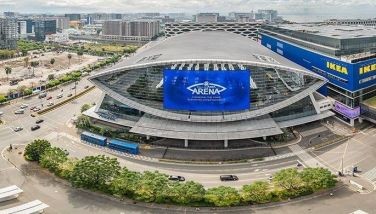LIA faces charges of plane smuggling
November 25, 2002 | 12:00am
Laoag International Airlines, whose old-model Fokker-27 plane crashed in Manila Bay last Nov. 11, is now facing charges of smuggling after the Bureau of Customs (BOC) confirmed LIA’s reported plane-smuggling activity.
In an eight-page report submitted to Customs Commissioner Antonio Bernardo last week, LIA was reported by Customs inspectors to have paid less than the required tariff for a Fokker plane marked L-410410 through misdeclaration.
"I still have to recheck the amount supposed to have been underpaid because my two investigators gave different figures," Bernardo told The STAR in a phone interview. "But based on the two figures, it was definitely underpaid."
Bernardo, however, did not elaborate on how the smuggling was carried out.
"I still have to verify the report myself. I cannot rush this. I will call the investigators," he said.
Bernardo noted that the investigation is still in the early stages although preliminary findings indicate smuggling on the part of LIA.
If it is proven that LIA smuggled its planes, charges of violating the Tariff and Customs Code can be filed against the airline.
Bernardo, however, could not say if the Fokker F-27 that crashed on Manila Bay was also smuggled into the country.
"I have given instructions for the investigation to include the other planes," he said.
The BOC investigation into LIA’s alleged plane smuggling started about two months ago after the bureau received an anonymous report on the illegal activity.
Meanwhile, Transportation and Communications Secretary Leandro Mendoza has ordered a review of the airworthiness of all small airlines following the crash of LIA Flight 585.
Transportation and Communications Undersecretary Arturo Valdez said the review will ensure that small airlines implement good maintenance and operational practices to prevent another crash.
"We are talking here of lives so we must ensure the airworthiness of airlines now in operation. We cannot be complacent about this," Valdez said.
The airline review will be spearheaded by the Air Transportation Office (ATO), which regulates the aviation industry.
Valdez, however, said there was also a need to reform the monitoring and regulation practices of ATO, an agency attached to the DOTC.
It appeared that during the three-day hearing conducted last week on the LIA crash, ATO failed to properly monitor LIA.
An ATO official said that the agency did not know LIA was not keeping a "discrepancy" book which supposedly contains the "mechanical history" of an aircraft.
The ATO was also found to have only 15 "check pilots" who inspect aircraft and evaluate the proficiency of pilots. To compensate for this shortage, ATO is hiring the services of commercial pilots to help in the evaluation.
Valdez said the DOTC intends to use the hearing as a venue to determine the reforms that need to be instituted in the aviation industry.
"The investigation is not only intended to give justice to those who survived and died in the crash. We hope to find out what we can do to improve our aviation industry. We’ll come up with policy reforms based on our investigation," he said.
Valdez heads the DOTC’s five-man fact-finding committee tasked to investigate the LIA crash that killed 19 of 34 people on board.
During the three-day hearing, the committee found that the main fuel switch of the ill-fated aircraft was shut off. This means that the fuel valve of the main tank was closed and the plane only consumed the limited fuel left in the collector’s tank.
Valdez noted that an aviation collector’s tank contains only 14 US liters of fuel, which enables an airplane to fly for only nine minutes. When the fuel runs out, the engine will break down. This happened to Flight 585, causing it to ditch into Manila Bay.
"There was apparently fuel starvation. The engine quit. But we do not know until now who switched off the main fuel switch," Valdez said.
In an eight-page report submitted to Customs Commissioner Antonio Bernardo last week, LIA was reported by Customs inspectors to have paid less than the required tariff for a Fokker plane marked L-410410 through misdeclaration.
"I still have to recheck the amount supposed to have been underpaid because my two investigators gave different figures," Bernardo told The STAR in a phone interview. "But based on the two figures, it was definitely underpaid."
Bernardo, however, did not elaborate on how the smuggling was carried out.
"I still have to verify the report myself. I cannot rush this. I will call the investigators," he said.
Bernardo noted that the investigation is still in the early stages although preliminary findings indicate smuggling on the part of LIA.
If it is proven that LIA smuggled its planes, charges of violating the Tariff and Customs Code can be filed against the airline.
Bernardo, however, could not say if the Fokker F-27 that crashed on Manila Bay was also smuggled into the country.
"I have given instructions for the investigation to include the other planes," he said.
The BOC investigation into LIA’s alleged plane smuggling started about two months ago after the bureau received an anonymous report on the illegal activity.
Meanwhile, Transportation and Communications Secretary Leandro Mendoza has ordered a review of the airworthiness of all small airlines following the crash of LIA Flight 585.
Transportation and Communications Undersecretary Arturo Valdez said the review will ensure that small airlines implement good maintenance and operational practices to prevent another crash.
"We are talking here of lives so we must ensure the airworthiness of airlines now in operation. We cannot be complacent about this," Valdez said.
The airline review will be spearheaded by the Air Transportation Office (ATO), which regulates the aviation industry.
Valdez, however, said there was also a need to reform the monitoring and regulation practices of ATO, an agency attached to the DOTC.
It appeared that during the three-day hearing conducted last week on the LIA crash, ATO failed to properly monitor LIA.
An ATO official said that the agency did not know LIA was not keeping a "discrepancy" book which supposedly contains the "mechanical history" of an aircraft.
The ATO was also found to have only 15 "check pilots" who inspect aircraft and evaluate the proficiency of pilots. To compensate for this shortage, ATO is hiring the services of commercial pilots to help in the evaluation.
Valdez said the DOTC intends to use the hearing as a venue to determine the reforms that need to be instituted in the aviation industry.
"The investigation is not only intended to give justice to those who survived and died in the crash. We hope to find out what we can do to improve our aviation industry. We’ll come up with policy reforms based on our investigation," he said.
Valdez heads the DOTC’s five-man fact-finding committee tasked to investigate the LIA crash that killed 19 of 34 people on board.
During the three-day hearing, the committee found that the main fuel switch of the ill-fated aircraft was shut off. This means that the fuel valve of the main tank was closed and the plane only consumed the limited fuel left in the collector’s tank.
Valdez noted that an aviation collector’s tank contains only 14 US liters of fuel, which enables an airplane to fly for only nine minutes. When the fuel runs out, the engine will break down. This happened to Flight 585, causing it to ditch into Manila Bay.
"There was apparently fuel starvation. The engine quit. But we do not know until now who switched off the main fuel switch," Valdez said.
BrandSpace Articles
<
>
- Latest
- Trending
Trending
Latest
Trending
Latest
Recommended































